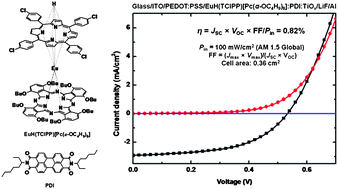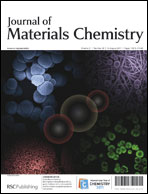Solution-processed organic-inorganic hybrid bulk heterojunction solar cells with the capability of broadband solar photon harvesting over the ultraviolet-visible-near-infrared spectral range are developed. A series of mixed (porphyrinato)(phthalocyaninato) rare-earth double-decker complexes, [MIIIH(TClPP){Pc(α-OC4H9)8}] (1–7; M = Y, Sm, Eu, Tb, Dy, Ho, Lu; TClPP = meso-tetrakis(4-chlorophenyl)porphyrinate; Pc(α-OC4H9)8 = 1,4,8,11,15,18,22,25-octakis(1-butyloxy)phthalocyaninate) and [YIII(TClPP)(Pc)] (8, Pc = unsubstituted phthalocyaninate), along with a heteroleptic bis(phthalocyaninato) yttrium double-decker complex [YIIIH(Pc){Pc(α-OC4H9)8}] (9), are synthesized and utilized as broadband absorbers and electron donors (D), whereas N,N′-bis(1-ethylhexyl)-3,4:9,10-perylenebis(dicarbox-imide) (PDI) or [6,6]-phenyl-C61 butyric acid methyl ester (PCBM) is adopted as primary electron acceptor (A1). For suppressing the fatal back charge transfer at D/A1 interface, the D:A1 blend is fabricated within an in situ formed cheap inorganic network of nanoporous TiOx, which can act as a secondary electron acceptor (A2). For characterization of these structures, steady state spectroscopy, fluorescence dynamics, atomic force microscopy, current–voltage characteristics, and photoelectrical properties of the active materials or devices are investigated. Solar cells utilizing PDI as the primary acceptor show higher values in open circuit voltage, fill factor, and power conversion efficiency over those cells using PCBM as the primary acceptor. With a cell area of 0.36 cm2, good efficiencies of up to 0.82% are achieved by the aforementioned double-decker complex:PDI:TiOx blends under 1-sun air mass 1.5 global illumination. These results conclude that double-decker bis(tetrapyrrole) complexes are promising photovoltaic materials with tunable absorption and photophysical properties.


 Please wait while we load your content...
Please wait while we load your content...